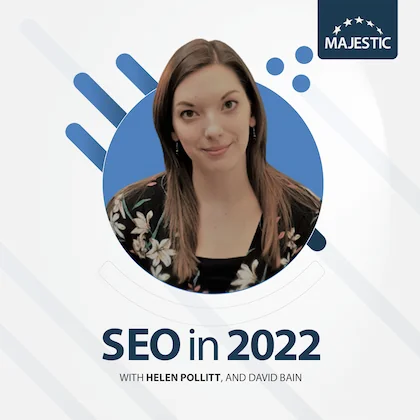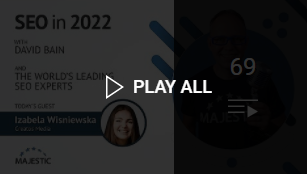-
Site Explorer
- Majestic
- Summary
- Ref Domains
- Backlinks
 New
New Lost
Lost- Context
- Anchor Text
- Pages
- Topics
- Link Graph
- Related Sites
- Advanced Tools
- Author ExplorerBeta
- Summary
- Similar Profiles
- Profile Backlinks
- Attributions
- Compare
-
Link Tools
- My Majestic
- Recent Activity
- Reports
- Campaigns
- Verified Domains
- OpenApps
- API Keys
- Keywords
- Keyword Generator
- Keyword Checker
- Search Explorer
- Link Tools
- Bulk Backlinks
- Neighbourhood Checker
- Submit URLs
- Experimental
- Index Merger
- Link Profile Fight
- Mutual Links
- Solo Links
- PDF Report
- Typo Domain
- Free SEO Tools
-
Support
- Blog

- Support
- Get started
- Tools
- Subscriptions & Billing
- FAQs
- Glossary
- How To Videos
- API Reference Guide

- Contact Us
- About Backlinks and SEO
- SEO in 2024
- Link Building Guides
- Webinars
- Blog
Employ intent mapping for every core page on your site
Helen Pollitt
According to Helen, intent mapping is something that you need to be applying for every core page on your site.

Employ intent mapping for every core page on your site
Helen says: "You need to consider granular intent mapping for every core page on your site. By intent mapping, I mean, making sure you understand what someone landing on your core pages wants to do when they get to them. That should inform the type of content, and how it's displayed and signposted on those pages. Intent mapping should dictate everything about the content, and the user journey through your site from your landing page."
How does an SEO become confident of the intent? Is there a certain place to start gathering information from customers, and how do you translate that into intent?
"I start right at the basics: doing good keyword research - getting yourself a seed list of keywords, and then understanding what someone searching for this particular query might be looking for. Sometimes, it's obvious. If someone is searching for 'karaoke bars near me', you know what they're looking for. If they are searching forbest karaoke bars near me, then you can start to infer that there might be some criteria to set against that list of karaoke bars. Just from reading through the seed keyword list, and whittling that down, you should be able to understand what the intent is.
From there, I look to see what Google thinks the intent is. I put those keywords into Google and see what sort of search results are returned. That helps you to understand what Google might decide the intent is, and that might change over time. It's worth repeating this whilst optimising landing pages if you're doing this over a long period of time. It's also worth looking at some of the conversations that you're having with your customers - your visitors to your site. If you have call logs, or you can speak to your customer service team, you can get an understanding of what your customers are talking about, and what they mean by the language they're using. This helps you start to understand the mindset of your customers."
Where do you draw the line when deciding where it is worthwhile having separate distinct pages on your website?
"It might not be worthwhile having separate pages. Instead, intent mapping informs the type of content you have on your pages. Those pages might not just contain information that is mapped to one intent. It might be that people with slightly different intent are still able to find what they need from that one page.
In my 'karaoke bars' example, you might decide that if someone types 'karaoke bars near me', then their intent is just a list of relevant bars in their geography. You might not optimise for that search phrase at all, because Google Maps has probably swept up most of the traffic there. Instead, you might look at search phrases like 'best karaoke bars near me' or 'what should I do on a night out', where the intent might be slightly different. Then, you would be able to craft content for one page that meets all the needs of those users. It's worth considering whether you can create a really rich page that covers multiple intents that are similar, rather than having individual pages. You might see an overlap of the intent behind those pages."
Would you categorise intents that were quite similar and create H2 heading sections on your page to deal with the different intents you've identified?
"Potentially, yes. If we think about paragraph indexing and how Google is starting to pull out distinct bits of information from pages, we can start to understand how it might be able to deal with pages that have slightly mixed intent. However, as long as you are distinct in mapping the intent against those pages, I don't think that would be an issue."
How do you define what your core pages are?
"It's the pages generating the conversion that you're measuring. It might be the actual revenue, your product pages, or your pages leading to forms being filled in. However, it's not just the pages that convert, it might also be the pages that are attracting people at the top of the marketing funnel. It might be your longer-tail keyword pages, ones that are answering questions, or blog pages, or anything you think is bringing in an attracted audience at the top of the user journey that can be brought down the marketing funnel. It's about the pages that are likely to really engage your audience."
Is this strategy for any type of business?
"Yes - any business that has a website. It's really for anyone wanting to engage users on their website."
Is there a particular frequency with which intent mapping should be carried out?
"It's definitely not 'set and forget', but it's also not necessarily something you would be scheduling in. You need to keep an eye on your data - if you're noticing that click-through, rankings or traffic are dropping, then you need to start auditing those pages. As part of that audit, you need to look at the intent mapping. Has Google started to favour different types of content over the content on your page? Have the search terms changed to an extent whereby the perceived intent behind a keyword is no longer the actual intent behind that keyword?
You may need to change how you are structuring your page as well as the content that's on your page. When you choose to carry out intent mapping needs to be in response to data."
How do you measure the success of your intent mapping?
"You need to measure quality of traffic over quantity of traffic, because quantity of traffic isn't necessarily going to lead to the conversions you want. Intent mapping is about making sure the right people are coming to your page. It's about ensuring that there is a good level of organic traffic coming to your site that is actually converting. You might notice rankings go up for certain keywords and not for others, because your page becomes less relevant for the keywords that don't match the intent of the page. It's a combination of those sorts of metrics.
The focus needs to be on whether the traffic coming to your page is carrying out the activities that you want. That might not be a conversion - it could be click-throughs to other pages, a continuation of the user journey through the website, or a purchase. It depends on what the purpose of that page is, and what you want the user to do."
Is this strategy only suitable for existing content, or can it be implemented in new content?
"Intent mapping is very much suitable for existing content - for optimising and tweaking it to make it more effective. However, it is also a strategy that absolutely has to happen for new content. You should not be putting content on a site unless you know who it is for, and what you want them to do once they've read it. When you're putting new content onto a site, or even when you're building your site from scratch, you need to think: What is the point of this page? What is it trying to do? What sort of user do I expect to come to this page?
All of that information should be informing your UX, design and content writing teams. Content writers, for instance, need to know who their audience is, what they are looking to do, and what you're looking to guide them to do. Without intent mapping, it's difficult for a content writer to produce something that is going to be effective."
Do you think intent mapping should be led by an SEO, or is it a suitable strategy for someone else within a marketing department?
"That very much depends on the politics within your organisation. I would love to say that an SEO should be spearheading it, because it's something that I think all SEO should be excited to be doing. However, it might be better suited to someone who's been upskilled within the content marketing team to understand keyword research and intent mapping, or perhaps for a product manager to be leading. It very much depends on how your organisation is structured. Regardless, it's definitely something that the SEO should have input on, and it's something they should be excited to be working on."
What's the one thing that SEOs should stop doing to focus more time on learning and implementing intent mapping?
"Spend less time trying to carefully sculpt your search results - meaning the snippets that are going to be displayed in Google - because Google is probably going to be changing those a lot more in the future. In the past, you may have spent a lot of time trying to craft the perfect meta title or make a perfect meta description, but I can see that kind of activity becoming less and less fruitful. I would suggest your time is better spent making sure the landing pages meet the user's exact needs, because that will make you more likely to rank - despite whatever Google decides to show as your search snippet. With effective intent mapping, you're more likely to convert your visitors when they land on your pages."
You can find Helen Pollitt over at Car and Classic.
Choose Your Own Learning Style
 Video
Video
If you like to get up-close with your favourite SEO experts, these one-to-one interviews might just be for you.
Watch all of our episodes, FREE, on our dedicated SEO in 2022 playlist.
 Podcast
Podcast
Maybe you are more of a listener than a watcher, or prefer to learn while you commute.
SEO in 2022 is available now via all the usual podcast platforms
Don't miss out
Opt-in to receive email updates.
It's the fastest way to find out more about SEO in 2025.
Could we improve this page for you? Please tell us





